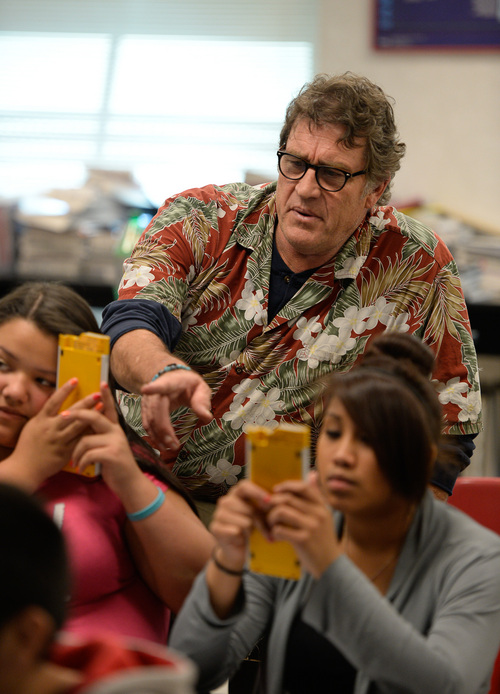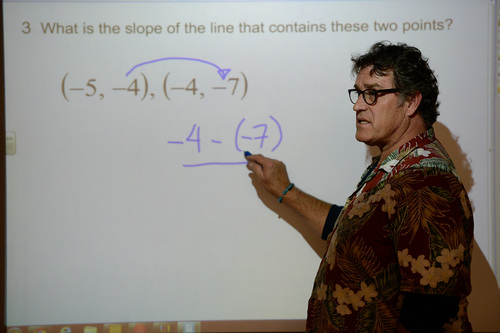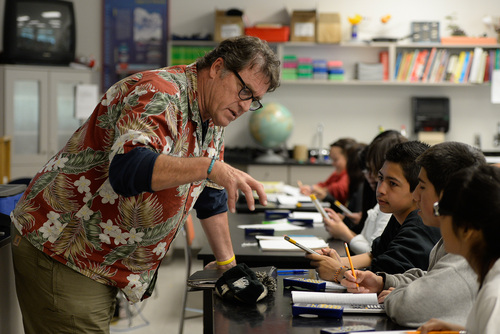This is an archived article that was published on sltrib.com in 2014, and information in the article may be outdated. It is provided only for personal research purposes and may not be reprinted.
As eighth-graders at Northwest Middle School reviewed for end-of-year math tests, they had to figure out the length of a ladder using the Pythagorean Theorem. They also had to figure out the volume of corn in a silo that was part cylinder and part cone.
They used pencils and paper, T1-Nspire hand-held computers and student response "clickers" to let teacher Roger Haglund know their answers.
Haglund could tell by glancing at his Smart Board who was and was not getting it — an assessment that would have taken much longer if he'd had to look at all their papers.
"Anthony and George, come on. Let's go!" he said, noticing that two students had not yet "clicked" in their answers.
"This is a 30-second question. When the next Pythagorean Theorem comes up, you've got one minute to answer it."
It's not hard to picture Haglund as he used to be, a swimming instructor who would push kids to do what they thought they couldn't. Now he blends his coach-style cajoling — "Stop saying, 'I don't know how!' " — with electronic devices to engage seventh- and eighth-graders in math and science.
"A lot of this is figuring out how to reach them," says Haglund. "These kids don't know anything except digital devices."
Haglund, the general manager at the Salt Lake Swimming and Tennis Club before he became a teacher 12 years ago, is one of five Utah teachers selected for KUED-The Salt Lake Tribune Teacher Innovation Awards.
Besides the hand-held computers and clickers, Haglund has flip cameras and 40 iPods in his classroom. Much of the technology was purchased with a $1 million federal grant to the school several years ago.
His eighth-grade science students wrote scripts and used the cameras to shoot videos of themselves explaining science concepts, such as photosynthesis, to seventh-graders.
Devices, Haglund says, are often a good way to engage children who are not native English speakers. Of Northwest's students, nearly two-thirds do not speak English at home.
He keeps one of his favorite videos on his desktop computer. It shows three boys — two from Burma and one from Somalia — explaining exponential multiplication and division.
"They didn't speak 20 words in front of other people [before]," Haglund says, "but they ended up demonstrating their knowledge."
All the technology, Haglund believes, has contributed to Northwest's success, which was lauded by U.S. Secretary of Education Arne Duncan in a visit to the school last December.
Three years ago, 37 percent of students were proficient on end-of-year tests in math. Last spring, 79 percent were proficient.
"A lot of the reason," says Haglund, "is our use of technology."
Haglund does not have an education degree; he has a physics degree and got his teaching license by an alternative route.
Northwest Principal Brian Conley says some teachers build "curriculum castles" that they refuse to change year to year. But Haglund is always looking for ways to improve what he teaches.
"When it comes to learning something new, he's like a sponge. He checks his ego at the door," Conley says. "His focus is not just making it culturally relevant, but more generationally relevant than your average classroom."
kmoulton@sltrib.com
Twitter: @KristenMoulton ——
Innovation documentary airs Thursday
Five Utah teachers have been selected for KUED-The Salt Lake Tribune Teacher Innovation Awards, which celebrate their creative use of technology in classrooms.
The awards were given in the categories of arts, math, language arts, science and social studies.
The winners are being profiled in a continuing Tribune series this week and in a half-hour documentary airing Thursday at 7 p.m. on KUED-Channel 7.













